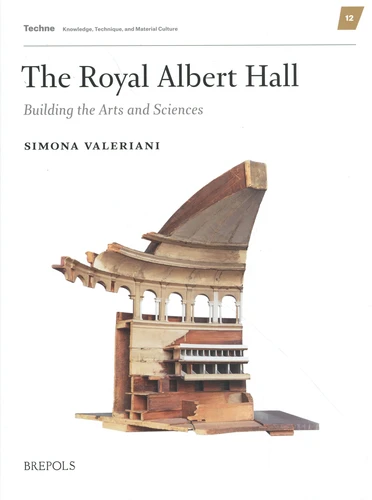The Royal Albert Hall. Building the Arts and Sciences
Par :Formats :
- Paiement en ligne :
- Livraison à domicile ou en point Mondial Relay indisponible
- Retrait Click and Collect en magasin gratuit
- Réservation en ligne avec paiement en magasin :
- Indisponible pour réserver et payer en magasin
- Nombre de pages322
- PrésentationRelié
- FormatGrand Format
- Poids1.59 kg
- Dimensions22,0 cm × 28,5 cm × 2,5 cm
- ISBN978-2-503-60026-0
- EAN9782503600260
- Date de parution01/01/2025
- CollectionTechne. Knowledge, Technique,
- ÉditeurBrepols
Résumé
This groundbreaking study takes one of London's most iconic buildings and deconstructs it to offer new insights into the society that produced it. As part of the new cultural quarter built in South Kensington on the proceeds from The Great Exhibition of 1851, the Royal Albert Hall was originally intended to be a "Central Hall of Arts and Sciences". Prince Albert's overarching vision was to promore technological and industrial progress to a wider audience, and in so doing increase its cultural and economic reach.
Placing materiality at its core, this volume provides an intellectual history of Victorian ideas about technology, progress, and prosperity. The narrative is underpinned by a wealth of new sources - from architectural models and archival materials to nineteenth-century newspapers. Each chapter focuses on a particular element of the Hall's construction, chronicling the previously overlooked work of a host of contributors from all walks of life, including female mosaic-makers and the Royal Engineers.
This book shows, for the first time, how the Hall's building was itself a crucible for innovation. Illustrious techniques from Antiquity were reimagined for the new mechanical age, placing the building at the heart of a process of collecting, describing, and systematising arts and practices. At the same time, the Royal Albert Hall was conceived as a symbolic cultural hub for the British Empire's metropole, a "manifesto" of what the Victorians thought Britain ought to be at a crucial moment in its socio-economic history.
This is the Royal Albert Hall : a central piece of the puzzle in Britain's march towards modernity.
Placing materiality at its core, this volume provides an intellectual history of Victorian ideas about technology, progress, and prosperity. The narrative is underpinned by a wealth of new sources - from architectural models and archival materials to nineteenth-century newspapers. Each chapter focuses on a particular element of the Hall's construction, chronicling the previously overlooked work of a host of contributors from all walks of life, including female mosaic-makers and the Royal Engineers.
This book shows, for the first time, how the Hall's building was itself a crucible for innovation. Illustrious techniques from Antiquity were reimagined for the new mechanical age, placing the building at the heart of a process of collecting, describing, and systematising arts and practices. At the same time, the Royal Albert Hall was conceived as a symbolic cultural hub for the British Empire's metropole, a "manifesto" of what the Victorians thought Britain ought to be at a crucial moment in its socio-economic history.
This is the Royal Albert Hall : a central piece of the puzzle in Britain's march towards modernity.
This groundbreaking study takes one of London's most iconic buildings and deconstructs it to offer new insights into the society that produced it. As part of the new cultural quarter built in South Kensington on the proceeds from The Great Exhibition of 1851, the Royal Albert Hall was originally intended to be a "Central Hall of Arts and Sciences". Prince Albert's overarching vision was to promore technological and industrial progress to a wider audience, and in so doing increase its cultural and economic reach.
Placing materiality at its core, this volume provides an intellectual history of Victorian ideas about technology, progress, and prosperity. The narrative is underpinned by a wealth of new sources - from architectural models and archival materials to nineteenth-century newspapers. Each chapter focuses on a particular element of the Hall's construction, chronicling the previously overlooked work of a host of contributors from all walks of life, including female mosaic-makers and the Royal Engineers.
This book shows, for the first time, how the Hall's building was itself a crucible for innovation. Illustrious techniques from Antiquity were reimagined for the new mechanical age, placing the building at the heart of a process of collecting, describing, and systematising arts and practices. At the same time, the Royal Albert Hall was conceived as a symbolic cultural hub for the British Empire's metropole, a "manifesto" of what the Victorians thought Britain ought to be at a crucial moment in its socio-economic history.
This is the Royal Albert Hall : a central piece of the puzzle in Britain's march towards modernity.
Placing materiality at its core, this volume provides an intellectual history of Victorian ideas about technology, progress, and prosperity. The narrative is underpinned by a wealth of new sources - from architectural models and archival materials to nineteenth-century newspapers. Each chapter focuses on a particular element of the Hall's construction, chronicling the previously overlooked work of a host of contributors from all walks of life, including female mosaic-makers and the Royal Engineers.
This book shows, for the first time, how the Hall's building was itself a crucible for innovation. Illustrious techniques from Antiquity were reimagined for the new mechanical age, placing the building at the heart of a process of collecting, describing, and systematising arts and practices. At the same time, the Royal Albert Hall was conceived as a symbolic cultural hub for the British Empire's metropole, a "manifesto" of what the Victorians thought Britain ought to be at a crucial moment in its socio-economic history.
This is the Royal Albert Hall : a central piece of the puzzle in Britain's march towards modernity.


